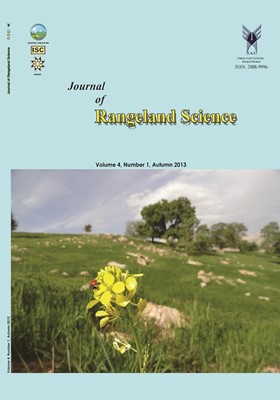Assessment of Climatic Drought and Its Economic Effects (Case Study: South Khorasan Province)
محورهای موضوعی : Relationship between Animal and RangelandSara Nakhaee Nezhad Fard 1 , Kamran Karimi 2 , Hassan Khosravi 3
1 - Deserts Region Management, Faculty of Natural Resources University of Tehran
2 - Deserts Region Management, Faculty of Natural Resources University of Tehran
3 - Faculty of Natural Resources, University of Tehran
کلید واژه: Zoning climate drought, Economical drought, SPI, ArcGIS 9.3, South Khorasan,
چکیده مقاله :
In this research Standardized Precipitation Index (SPI) in a period of 22 years(1990 to 2011) was used for zoning of climatic and agricultural drought in South Khorasanprovince, Iran. Rainfall data of six synoptic stations were collected and used for evaluationof meteorological drought. Also, reports of some local offices such as natural resources,agriculture, regional water and environment department were provided to study the effectof agricultural economic drought. At first, the elevation-precipitation regression of eachperiod was obtained then this relationship was applied on Digital Evaluation Model (DEM)layer using ArcGIS 9.3 software. The result showed that the most severity droughtsoccurred in 2008, 2000, 2006 and 2011 respectively. In 2008 more than 66% of the studyarea were classified as extremely drought class. The result of agricultural drought showedthat the total annual rangelands forage production of South Khorasan province thatexpected to be 625000 tons reduced to 250000 tons during period of 2007 to 2011. Alsothe agricultural production was faced with 45% reduction and caused rising poverty andunemployment, immigration from rural area to urban, in evacuated villages.
Anonymous, 2012. Regional Water organization
in South Khorasan, reports and data, 2007-2011.
Anonymous, 2012. Department of environment
organization in South Khorasan, reports and
data, 2007-2011.
Anonymous, 2012. Jihad- Keshavarzi
organization in South Khorasan, reports and
data, 2005-2011.
Banivaheb, A. and Alijani, B., 2005. Study of
drought, wet year and predict climate change in
Birjand using statistical models. Iranian Jour.
Geographical Research, 52: P 33-45. (In
Persian).
Barouti, H., Avali, R. and Emam Gholizade, S.,
2009. Analyzing and monitoring drought
indices using SPI in Ghazvin province,
international conference of water Resources,
Shahrood University, Iran. (In Persian).
Benson, M. and Edvard, C., 1998. The impact of
drought on sub-saharan African Economies.
World Bank Technical paper, no. 401.
Beran, M. A. and Rodier, J. A., 1985.
Hydrological aspects of drought. UNESCOWMO studies and reports in Hydrology, 39:
149.
Edossa, D. C., Babel, M. S., and Gupta, A. D.,
2010. Drought analysis in the Awash river
basin, Ethiopia. Water Resource Manage, 24:
1440–1460.
Edwards, D. C., and McKee, T. B., 1997.
Characteristics of 20th century drought in the
United States at multiple time scales.
Atmospheric Science Paper, 634: 1–30.
Ershadi, S., 2007. Model of dynamic monitoring
and prediction of drought in Iran and the
analysis it for the eastern regions of this
country, M.Sc. thesis for Irrigation and
Drainage. University of Mashhad. (In Persian).
Guttman, N. B., 1998. Comparing the palmer
drought index and the standardized precipitation
index. Jour. The American Water Resources
Association, 34: 113–121.
Jahanbakhsh, S. and Hooshyari, P., 2007. Effect
of drought on agriculture in Pars Abad Moghan,
university of Tabriz, Iran. (In Persian).
Jamali, J., Javanmard, S., and Shirmohamadi, R.,
2002. Zoning drought in Khorasan province
using SPI. Iranian Jour. Geographical
Research, 67: 550. P 4-21. (In Persian).
Khalaji, M., and Shayan Nejad, M., 2002.
Determining of severity and duration of drought
by using a new modified method for combating
with water deficit crisis in Shahrekord, Zahedan
and Zabol regions, The first conference of
challenging with deficit water crisis, Kerman, P
127-143. (In Persian).
Khalili, D., Farnoud, T., Jamshidi, H., KamgarHaghighi, A., and Zand-Parsa, S., 2011.
Comparability analysis of the SPI and RDI
meteorological drought indices in different
climatic zones. Springer science business media
B.V. Water Resource Manage, 25: 1737–1757.
(In Persian).
Mckee, T. B., Doesken, N. J., and kleist, J., 1993.
The relationship of drought frequency and
duration to time scales. Preprints, 8th
Conference on Applied Climatology, 17-22
January, Anaheim, CA, 170-184.
McKee, T. B., Doesken, N. J., and Kleist, J.,
1995. Drought monitoring with multiple time
scales. In Proceeding of the Ninth Conference
on Applied Climatology, Dallas, TX, American
Meteorological Society: 233–236.
National Disaster Management Organization of
Iran, reports and data, 2000-2011.
Natural Resources organization in South
Khorasan, reports and data, 2005-2011.
Negaresh, H., and Khosravi, M., 2000. Study
of agricultural climate project in Sistan and
Bluchestan province, university of Zahedan,
Agricultural and Resource Economics, 48: 225–
251. (In Persian).
Pandey, R. P., Pandey, A., Galkate, R. V., Byun,
H. R., and Mal, B. C., 2010. Integrating hydrometeorological and physiographic factors for
assessment of vulnerability to drought. Water
Resource Manage, 24: 4199–4217.
Quiggin, J., and Chambers, R. G., 2004. Drought
policy: a graphical analysis, Australian Jour.
Tsakiris, G., Rossi, G., Iglesias, A., Tsiourtis, N.,
Garrote, L. and Cancelliere, A., 2006. Drought
Indicators Report. Report made for the needs of
the European Research Program MEDROPLAN
(Mediterranean Drought Preparedness and
Mitigation Planning).
Vasiliades, L., and Athanasios L., 2007.
Hydrological response to meteorological
drought using the Palmer drought indices in
Thessaly, Greece, Desalination. 237: 3-21.
Vasiliades, L., Loukas, A., and Liberis, N., 2010.
A water balanced derived drought index for
Pinios River Basin, Greece. Water Resource
Manage. doi:10.1007/s11269-010-9665-1.
Wilhite, D. A., and Glantz, M. H., 1985.
Understanding the drought phenomenon: the role
of definitions. Water International, 10: 111-120.


